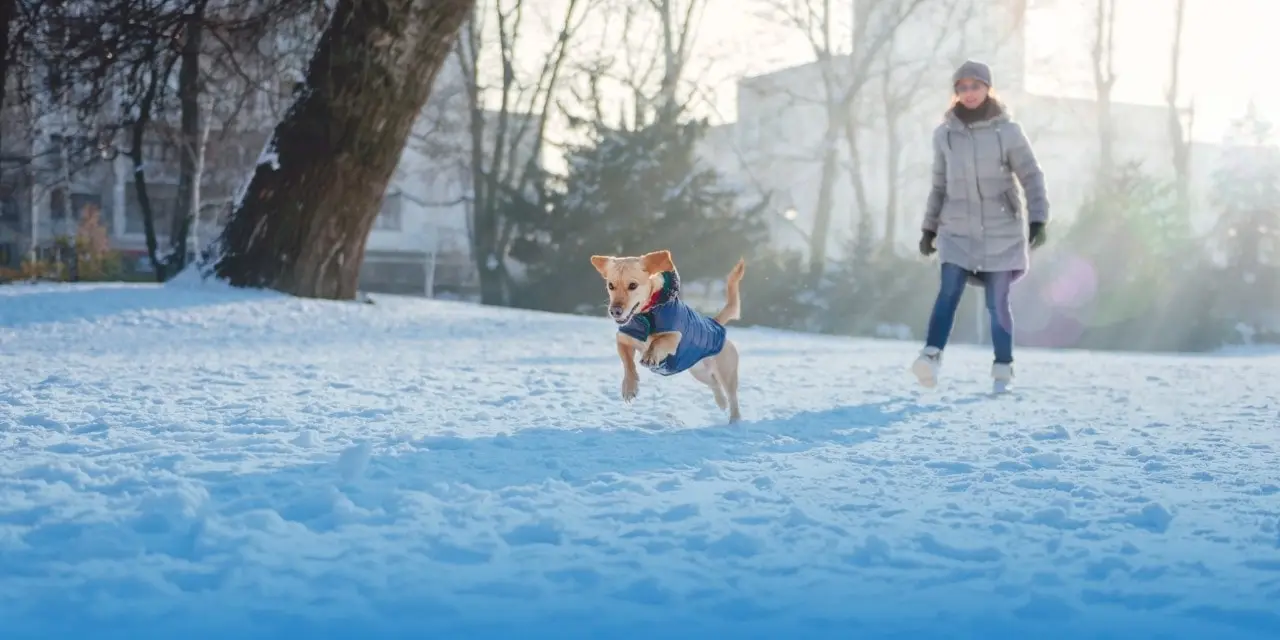PET BEHAVIOR
So you just got a new cuddly companion that you can’t wait to begin training. But there’s just one problem: it’s cold outside. Really cold. Yes, winter is here again, and while it may not be the most pleasant time to go outdoors with a rambunctious young pup, that doesn’t mean it shouldn’t be done.
In fact, it should be done, because the outdoors are where an impressionable young dog is apt to explore and learn the most. Plus, in the winter, there’s less people outside, which means less noises, less dogs that aren’t yours and less distractions. However, it’s important to keep your dog (and yourself) safe and warm in this adverse season.
There’s no reason to avoid the outdoors when you and your pup are prepared for it, especially when you have some commands you would like to teach your pet. Here’s six useful tips to help you both stay safe, warm and successful while keeping up with your dog’s various training regimens in the frigid winter months.
Keep Up House-Training
Perhaps the most bothersome of all winter annoyances, house-training progress can be hindered when the temperature drops. Try putting your dog on a schedule, taking him or her outside every day around the same times to use the potty.
First thing in the morning and last thing at night are essentials, with additional breaks in between. The younger your dog, the more bathroom breaks he or she will need. Spend time watching your dog’s behavior after eating to identify patterns, and always be there to accompany bathroom breaks (keep a coat handy!). Also, try shoveling out an accessible spot in the yard for your dog to potty a bit more comfortably.
Monitor Behavior & Look for Signals
After following a regimen long enough, your pup will learn outside is the place for potty time, regardless of the weather. He or she should start letting you know when it’s time to go, so watch for signs. Remember that if your puppy’s under three months old, accidents will be inevitable.
According to the Humane Society, puppies can hold their bladder one hour for every month of age. As your pup gets older, however, signs to watch for include sniffing, restlessness, circling about and lingering by the door. This last indicator means your pup is finally picking up on its housetraining.Just remember to keep accompanying your dog, as this will serve to further encourage good behavior.
Award Good Behavior
Whether you’re potty training, teaching a puppy how to speak or trying to prevent begging, keep rewards handy just as you would during the warmer months. This will provide further encouragement to briefly brave the cold. If you are specifically focused on potty training, give a treat when your dog tells you he or she needs to go outside, then another treat after they go. This will help your dog to understand each thing that’s being done right.
Beware of Frostbite
Frostbite most commonly affects dogs on their ears, tails and toes. There are many signs of frostbite: discoloration of the skin, coldness to the touch and swelling.
Fortunately, frostbite is often treatable, but it can be avoided altogether if you simply don’t keep your dog out longer than you should. Puppies are especially vulnerable, so be wary about straying too far when going for walks. Start slow and see how they react.
Add a minute or two to you outdoor activities each day if they seem to be reacting well, and always have a dry blanket or other warm article on hand if they get too cold. Dog coats and sweaters are also available in a wide variety of fabrics and patterns.
Take Care of Those Paws
Get in the habit of checking and cleaning your puppy’s paws each time he or she comes inside after training sessions.The salt used for deicing roads in the winter can lead to sore, cracked paws once it dries.
This is easily preventable if you make sure to wash your dog’s toes and pads with warm (never hot!) water to remove any residual salt after walks, then dry them thoroughly. After a bit of conditioning, your dog will learn to wait on his or her own before barging indoors, which will also help you keep your house clean during muddy or wet days.
Teach Indoors
When all else fails, just remember you don’t always need to brave the frigid elements to teach your dog some of the classics. “Sit”, “come”, “stay” and “down” are all basic introductory commands you can work on teaching even the youngest of pups within the comfort of your home, at the very least ensuring the season doesn’t pass by without any progress. But don’t rely too heavily on teaching indoors; it’s important to make sure your puppy learns to obey your commands outside, as well, which can only be done by practicing outside.
Just like older dogs, some puppies love the snow, but many others hate it. Take the time to familiarize yourself with your puppy’s unique cold weatherhabits, likes and dislikes. Training takes time, and it’s a learning process for all parties involved, so be patient and persistent. You’ll eventually see the results you’re wanting, without having to wait for spring to come around.
Consider Dog Insurance
Looking for more ways to help keep your pup happy and healthy? Consider learning more about a dog insurance policy with MetLife Pet Insurance. Our dog insurance policies can help provide the coverage and care your furry family member deserves. Get your free quote today.

